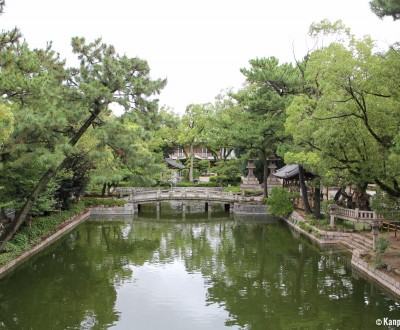Sumiyoshi Taisha
The great and old shrine of Osaka
Sumiyoshi Taisha is an important Shinto shrine located in the southern part of Osaka. Its very old origins, its renowned architecture, and regular attendance bestow to the place a current and lively trait, filled with spirituality.
A stone’s throw away south of Namba, the Sumiyoshi district reveals its station’s surroundings serving, from one part to the other, a vast public park including the famous Sumiyoshi Taisha Shrine, accessible on the east side.

The head shrine of all Sumiyoshi shrines in Japan
With a history of 1800 years, starting in 211, Sumiyoshi Taisha is one of the most renowned shrines in the country, representing its lineage across all Japan. The archipelago includes about 2,300 other complexes. Just like the Izumo Taisha and Ise-Jingu’s buildings, its unique architecture is a Shinto style called sumiyoshi-zukuri. The main hall honden is obviously classified as a National Treasure.
Constructed before the arrival of Buddhism in Japan with Chinese monks, it is one of the oldest spiritual sites created in Japan. Originally, the shrine was closer to the ocean, before the land gain over the sea due to humans’ actions. This is the resume of this site, announcing rich visits full of symbols, loved by locals and tourists.

A major site of shinto cult in Kansai
The main attraction starts at the entrance with the canal underneath the gorgeous Sorihashi, nicknamed Taiko-bashi (the drum bridge) due to the reflection of its arch in the water, resembling the percussion instrument. Its shiny red color and strong slope bestow it an original form; stairs are actually necessary to cross it.
Then we enter the sacred interior, with a view of the main shrine, actually made of four buildings that are perfectly identical, three of which are aligned. Each building is dedicated to a deity kami and protects sailors, boats, and more broadly, the sea industry and travelers. The legendary empress Jingu Kogo is also worshipped here.
The outskirts of the complex allow visitors to enjoy pleasant wandering along the alleys, bordered with flags and hundreds of stone lanterns 🏮, some of them huge, and centenary cedar trees leading to several singular cult sites:
- Goshogozen: the most sacred place of the complex, where the deities appeared for the first time. To bring luck and happiness, fellow worshippers search for stones engraved with the Japanese characters Five 五 Go, Big 大 Dai, and Power 力 Riki.
- Nankun-sha: sort of a small shop lit with numerous lanterns, within which a Maneki Neko of a specific style can be bought, supporting professional success.
- Omakaru: a stone supposed to be lighter the second time it is carried to make wishes come true.
Two annual events attract millions of visitors:
- on New Year’s Eve to wish for a happy new year, and;
- during the Sumiyoshi Matsuri, starting on the Day of the Sea and continuing for three days, from July 30th to August 1st.
Also, the west exit of the train 🚅 station opens up on Sumiyoshi Park, which does not have any cultural or historical appeal. It is rather a classic green space for a lunch break around the pond, or for families to enjoy.

